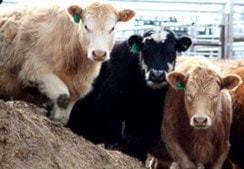By Jasmine Franklin
Describing the state of the beef industry as devastating would be an understatement.
After an eight-year decline, the province’s beef industry has taken a hard hit that has severely affected producers. From factors such as drought, the Canadian dollar, bovine spongiform encephalopathy (BSE) and trade restrictions, there has been a shadow cast over the business of beef.
However, Ponoka’s Greg Bowie, a director with the Alberta Beef Producers, believes there are options the industry may take.
The industry status
“There hasn’t been a good year for producers since 2001, in the sense that they have been unable to make a profit,” Bowie said. “Today, it’s just costing money — nobody in the industry right now is making any money. When it becomes beef there is a profit to be made but until then, it is rough.”
Bowie explained that the fed cattle market is still poor and producers are losing money.
A market report from Vold Jones & Vold March 10 shows good 1000 pound feeder steers, selling at 84 to 89 cents per pound; good feeder steers 300 pounds for $1.20 to $1.30; 900 pounds plus heifer, 85 to 89.5 cents and a 300 pound plus heifer for $1.00 to $1.08.
“No, it is not in good shape,” Bowie said. “But, I believe that leaves a lot of room to go forward with positive things. (For example), after the recession is over, the demand for beef again will pick up. Concerns of BSE will be mostly behind us and the trade restrictions will be, for the most part, over.”
Understanding the highs and lows of the industry are essential to recognizing how it got to where it is now.
How the industry got here
The Alberta cattle industry began in the late 1800s and the Canadian Journal of Agricultural Economics said the cow-calf production is the backbone of the beef industry in Alberta.
After a combination of recent pitfalls, the beef industry has taken a hard hit.
In 2003, Alberta and Canadian beef was dramatically affected by the BSE outbreak. Also known as “mad cow disease,” many countries such as the United States closed their borders to Canadian beef forcing trade restrictions on the product.
This severely affected the industry as Canada exports 70 per cent of its beef to the United States.
Peggy Checkel, from Farm Credit Canada (FCC), made a presentation in Ponoka last month titled “Let’s Talk About Beef,” and explained another problem facing the market was the feedlot industry that built on a low Canadian dollar. Because the market is dictated by U.S consumption and the dollar was decreasing, the industry was already entering a deflated market, Checkel said.
“Profit became tighter and feedlots couldn’t expand numbers to become more efficient so the way the cattle market ran had to change,” she said.
But not everything was negative.
Not long after the BSE outbreak, Bowie said the number of cattle in Alberta hit a record high in 2005. According to Alberta Agriculture and Rural Development, there were about 5,930 cattle and calves on farms in Alberta as compared to today’s 5,150 — comprising nearly 40 per cent of the nation’s cattle and calve population.
But with the effects of the Canadian dollar, the lingering BSE situation and closed borders, last year’s drought pushed many producers to take action.
“There was extreme drought over the larger part of Ponoka County,” Bowie said. “The hay and pasture was a fraction of normal because of that lack of moisture.”
Bowie said some producers downsized while others sold out completely. Many are still holding on but the drought was the last straw for a lot of producers.
“Even for me, I’m hanging on to my (90) cows but if there’s another drought I’ll have to sell,” Bowie said.
Bowie’s future prediction
“If the present trend continues, in a few years Canada will likely become a net importer for beef and pork and we will have to start buying from other countries with different beef standards — I don’t think consumers will appreciate that,” Bowie said. “I also think we will never see cow numbers in Alberta like we did in 2005. However, beef is a big part of agriculture and Alberta’s land was built on beef. Though things are low, I’m much happier to be a beef guy than a pork guy because pork has hit a historic low. Things are definitely going to change, but you have to adapt in any industry.”
Resources, links and statistics
According to Statistics Canada, since 2005 Alberta has been the leading province for national beef exports with $1.4 billion exported in 2005 and $1.1 billion in 2008. Second to Alberta is Ontario and third, Quebec.
Options for producers are varied. One way to ease financial burden on farmers, Bowie said is to look at alternative ways to feed cows.
“The traditional hay has become too expensive,” he said. “There are other ways to get the cattle through the winter healthily. For example, switch to straw and grain rations.”
Cattle farmers can look into insurance programs such as the Cattle Price Insurance Program (CPIP) that offers price insurance and basis insurance for beef cattle producers. The program was launched in September 2009 and offers coverage periods of 12 to 36 weeks with a 95 per-cent coverage of the estimated market. Visit www.afsc.ca for a deeper look into the program. Information on Alberta’s Farm Recovery Plan can also be found on this site.
Other options are to look into an Environmental Farm Plan (EFP) that helps to sustain production, manage risks and provide healthy landscapes for the next generations and maintaining market access. For more information on this program visit www.albertaefp.com
